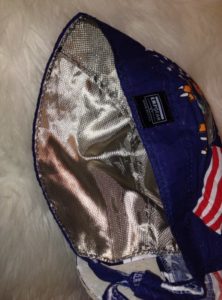The Faraday hat can be described as an EMF protection hat that stops radio waves from being transmitted to your brain. It's a tinfoil-lined helmet which is typically worn by those with electromagnetic hypersensitivity (EHS).
The tin foil hat functions as a Faraday cage, an enclosure that shields its interior from external electrostatic charges and electromagnetic radiation by distributing them around the exterior part of the cage.
What is the procedure? Faraday Cages Work
A Faraday cage is a metallic object that acts like an electric conductor. When an electric charge comes in proximity to it the electrons inside the conductive material immediately align themselves, and cancel out the charge that was incoming.
A Faraday cage's effectiveness depends on its design, size and construction materials. Also, they must be easily groundable, with seams and gaps that are trimmed.
The best Faraday cages block static electric charges as well as electromagnetic waves, safeguarding those conducting sensitive research that would be impeded by radiated radiation. MRI scanning rooms, for example must be Faraday caged to keep electromagnetic waves from interfering with the imaging process for diagnostic purposes.
Despite their incredible effectiveness, Faraday cages aren't perfect. Electrons can still get through a Faraday cage and cause damage to electronics within. This is why they're often used in high-powered labs to reduce noise and interference. They can also help to protect against electromagnetic pulses (EMPs) that are powerful weapons that are designed to destroy electronic components.
How Faraday Fabric Works
If it's radio waves Cell towers, Wi-Fi, or different sources of electromagnetic radiation. Interference could cause these connections to become unstable and interrupt the functioning of devices. In the end, numerous essential components are covered in protective materials such as copper foil to shield them.
However, these cages can be awkward and bulky. Researchers from Drexel University have developed a Faraday fabric which is flexible and durable. It is washable as well as washable.
This fabric is made from an 2D material known as MXene and can block almost all electromagnetic waves. In the future, clothes that are made with this technology can be used to shield clothing from electromagnetic interference as well as protect people from dangerous radiation.
Although this technology is currently being developed It's an intriguing idea for clothing. The team hopes that this fabric will lead to clothing that have RF-blocking pockets. faraday cage hat would be helpful for those who wish to keep their gadgets away from their heads when they use them. This could help in preventing an issue that is common to health - radiation causing brain tumors.
Faraday Cages Versus Faraday Fabric
If you're not familiar with Faraday cages Let's look at how they work If an electrical field comes in contact with metal conductors like aluminum mesh and aluminum mesh, it creates negative and positive particles to be separated. The redistribution of charge eliminates any electromagnetic waves that enter through.
This process permits utility workers to work near power lines without worry of getting electrocuted. This also keeps military equipment and other telecommunications equipment free from interference.
However, Faraday cages can be expensive, and aren't ideal for everyday use. That's why Faraday fabric comes in.
Faraday Fabric Versus Tin Foil
If you've heard of Faraday cages, you know that they're little more than a conductor that is all-encompassing that deflects or harmlessly absorbs electromagnetic radiation before it gets to sensitive electrical components protected within. This kind of shielding can also be found in elevators, scan rooms where MRI machines are located in, "booster bags" that shoplifters use to circumvent electronic security tags and even inside your microwave at home.
faraday hats -foil cover really be considered a Faraday cage?
To completely block radio waves the Faraday cage needs to be completely enclosed and sealed.
However, a tin-foil isn't able to do that, which is why it blocks radiation only in part.

Tin foil hats can amplify radio frequency. They supposedly do this by making use of resonance.
